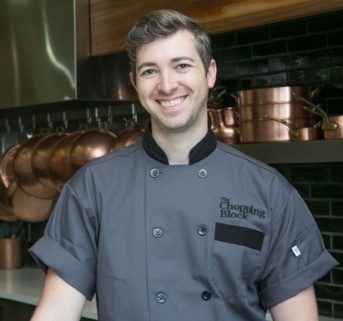Carbonara is one of my wife’s favorite pasta dishes, and I’m happy to make it for her whenever she requests it because unlike some of her other common requests it doesn’t take multiple days to prepare or two dozen unique ingredients. In fact, I can prepare carbonara about as quickly as I can make stovetop boxed Mac and cheese. Maybe even faster. Not only that, but it only requires a handful of ingredients. Considering it’s one of the world’s great pasta dishes, the lack of effort and forethought required to make it is really quite remarkable.
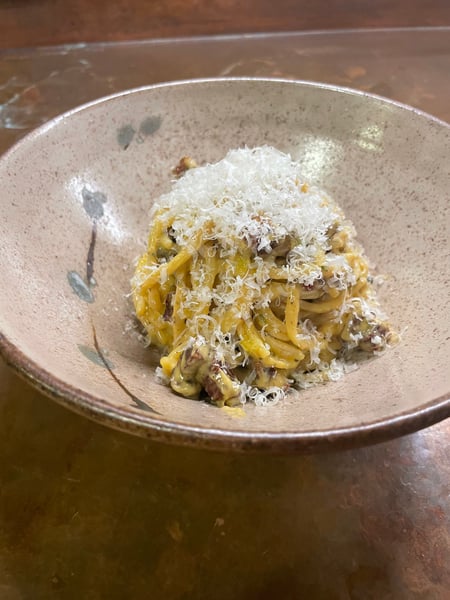 Winter is also my favorite time of year to eat carbonara. It is perfect for those lean months where fresh vegetables of any reasonable quality are hard to come by, and since it's made from ingredients you very well may already have at home, you don’t necessarily need to brave the weather to pick up ingredients. Not to mention the fact that it's composed of almost entirely carbs, meat, and cheese, it makes for an especially cozy winter’s meal.
Winter is also my favorite time of year to eat carbonara. It is perfect for those lean months where fresh vegetables of any reasonable quality are hard to come by, and since it's made from ingredients you very well may already have at home, you don’t necessarily need to brave the weather to pick up ingredients. Not to mention the fact that it's composed of almost entirely carbs, meat, and cheese, it makes for an especially cozy winter’s meal.
Now the version I’ll be making isn’t 100% traditional, but all the tweaks I’m making are totally optional, and I’ll let you know in what way I'm deviating from the original preparation.
Since the dish is simply prepared, and requires so few ingredients, its best to use the highest quality versions of those ingredients you can get your hands on. Let’s go through them real quick.
First up is the pasta. I’m using dried spaghetti made using a bronze die. This type of pasta can usually be found at most grocery stores these days.
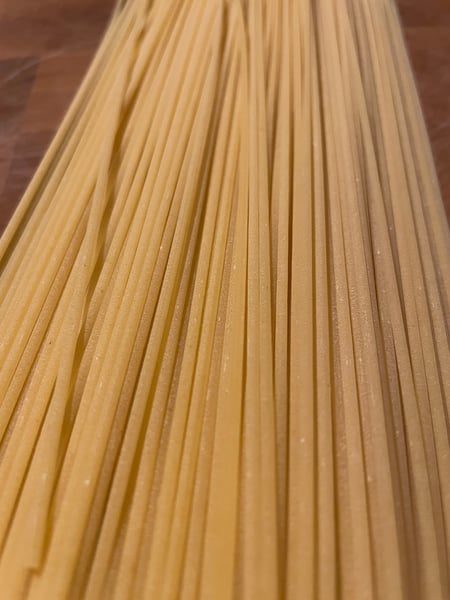 It's a little bit more expensive than typical boxed pasta, but the significantly better performance makes it worth it. Some people think fresh pasta is always better than dried pasta, but this simply isn’t the case. Especially for extruded pasta shapes like spaghetti, getting a good quality dried version will almost always outshine the fresh homemade stuff. This is for two reasons. First, it's almost impossible to make extruded pasta at home, and rolling out a sheet of pasta dough and cutting it into a spaghetti-like size just doesn’t produce the same shape. Second, and more important, is the texture on the surface of the pasta. A good quality dried pasta will look rough on the outside. This is the benefit of using a bronze die, and it means that when the pasta is sauced that rough surface will be able to hold a lot more sauce than the slick surface of home-rolled pasta. This is also the reason it is superior to the cheaper boxed pasta available at the grocery store. These lower end brands use Teflon-coated dies which allows them to make pasta much faster, but also results in a very smooth surface.
It's a little bit more expensive than typical boxed pasta, but the significantly better performance makes it worth it. Some people think fresh pasta is always better than dried pasta, but this simply isn’t the case. Especially for extruded pasta shapes like spaghetti, getting a good quality dried version will almost always outshine the fresh homemade stuff. This is for two reasons. First, it's almost impossible to make extruded pasta at home, and rolling out a sheet of pasta dough and cutting it into a spaghetti-like size just doesn’t produce the same shape. Second, and more important, is the texture on the surface of the pasta. A good quality dried pasta will look rough on the outside. This is the benefit of using a bronze die, and it means that when the pasta is sauced that rough surface will be able to hold a lot more sauce than the slick surface of home-rolled pasta. This is also the reason it is superior to the cheaper boxed pasta available at the grocery store. These lower end brands use Teflon-coated dies which allows them to make pasta much faster, but also results in a very smooth surface.
Second is the meat. Traditional carbonara is made from guanciale.
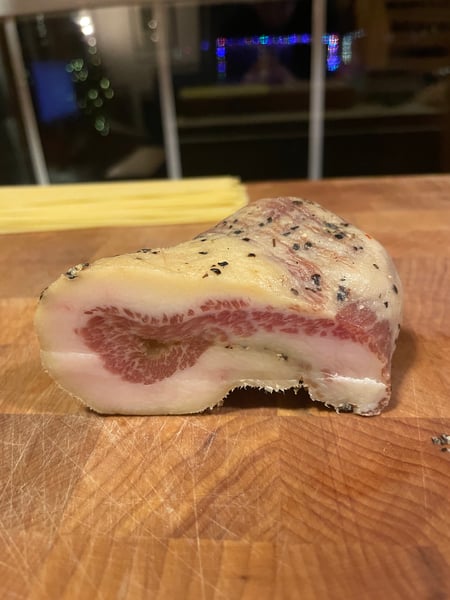 This is an Italian cured meat made from pork jowl. It's cured with herbs and spices and is similar to pancetta, but the texture of the fat on the jowl is unlike that on any other part of the pig. I highly recommend using guanciale if you can find it, but it can be tricky to track down. If you can’t find a high quality guanciale, then I recommend opting for pancetta or, least traditionally, bacon (tradition be damned - bacon is very delicious, works well in the recipe, and the additional smoky flavor it adds to the dish makes it, some might say, even better). It’s most important to use a high quality version of whatever meat you choose. Better to opt for a good quality bacon than a low or even middling quality guanciale.
This is an Italian cured meat made from pork jowl. It's cured with herbs and spices and is similar to pancetta, but the texture of the fat on the jowl is unlike that on any other part of the pig. I highly recommend using guanciale if you can find it, but it can be tricky to track down. If you can’t find a high quality guanciale, then I recommend opting for pancetta or, least traditionally, bacon (tradition be damned - bacon is very delicious, works well in the recipe, and the additional smoky flavor it adds to the dish makes it, some might say, even better). It’s most important to use a high quality version of whatever meat you choose. Better to opt for a good quality bacon than a low or even middling quality guanciale.
Third is the cheese. Traditionally you would use a Pecorino Romano to make carbonara, but I have access to much nicer Parmigiano Reggiano than I do Pecorino, so that's what I'm going to use.
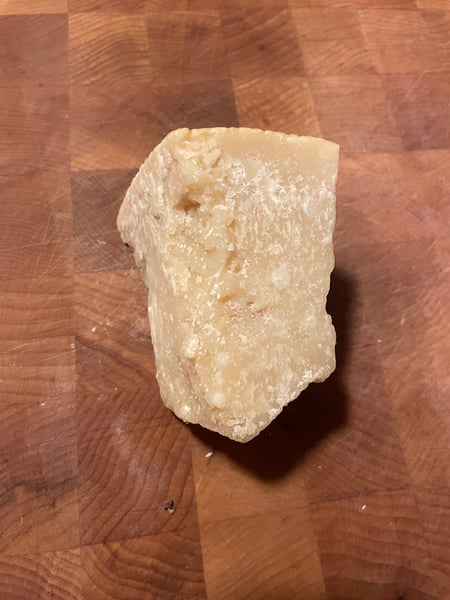
Again, its more important to use the best quality ingredient that fits the recipe than to use a lower quality “traditional” ingredient.
That's pretty much it as far as sourcing goes though. The other major ingredient—the eggs—is not so important because (hot take) all eggs taste the same (but that's another post). Other than that, it's just black pepper and, in my case, a little chicken stock, grapefruit zest, and winter savory, but these are all totally optional (except the pepper, and I’m pretty sure most people would have trouble differentiating between different types of black pepper in a dish, so long as its freshly cracked).
So with all that preamble out of the way, let's get into the recipe itself.
Spaghetti Carbonara
Scroll down for a printable version of this recipe
Serves: 2 main dish portions
Prep Time: 10 minutes
Cook Time: 15 minutes
150-200 grams dried spaghetti (or long pasta of your choice)
100 grams Guanciale (or pancetta or bacon) cut into small dice
2 whole eggs
2 egg yolks
50 grams finely grated Parmigiano Reggiano (or Pecorino Romano if you prefer)
1 teaspoon finely ground black pepper
200 grams chicken stock (optional)
1 teaspoon grapefruit zest (optional)
1 teaspoon chopped winter savory (optional)
Salt to taste
Normally, I am a big advocate for getting all of your ingredients prepped and organized before you begin cooking, but in this case the dish requires so little prep, and a couple of the ingredients take so long to cook (the pasta, and the guanciale) that you can actually go much faster by prepping ingredients while others are cooking. Just this once, forget the mise en place - it's okay.
Place a large covered pot of salted water over high heat and bring to a boil. While it's heating, weigh out your pasta and guanciale.
As soon as the water comes to a boil, drop in the pasta. If your spaghetti protrude from the surface of the water simply wait a few seconds for the noodles to soften and push them down to fully submerge them.
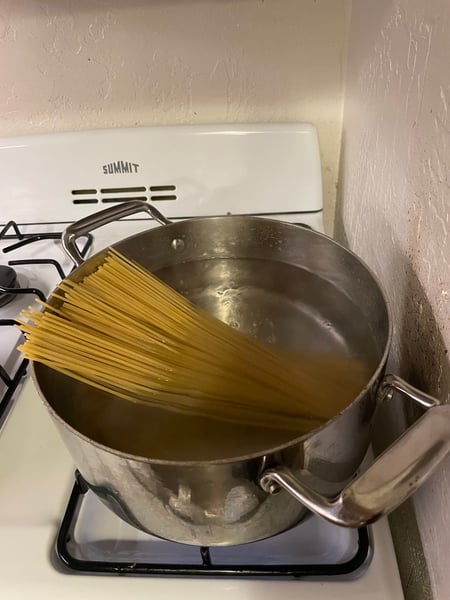
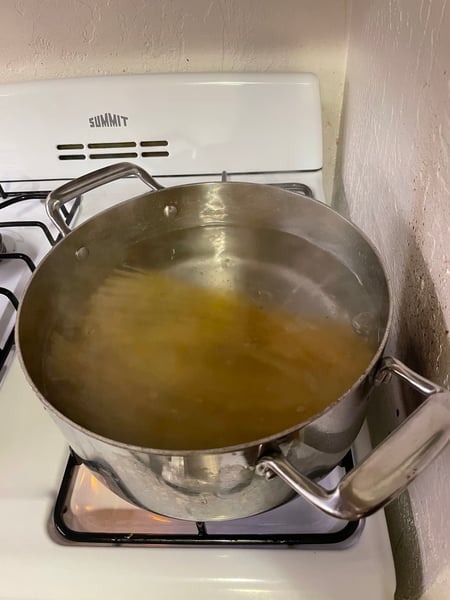 Do not—I repeat—do not break your pasta in half to get it to fit in the pot while it's still hard. If spaghetti was meant to be that short, the Italians would have made it that short.
Do not—I repeat—do not break your pasta in half to get it to fit in the pot while it's still hard. If spaghetti was meant to be that short, the Italians would have made it that short.
Also while you’re waiting for the pasta water to boil, dice the guanciale and get it cooking in a wide shallow pan set over medium-low heat.
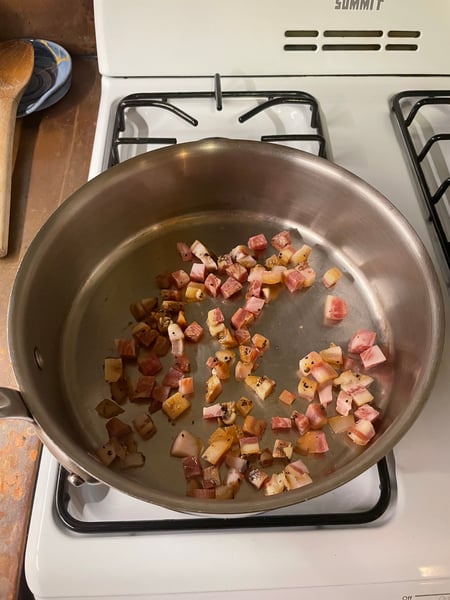 Cook, stirring occasionally, until the fat is well rendered and guanciale pieces are crispy. Some recipes will have you remove the cooked guanciale from the pan and get rid of the fat, but the rendered guanciale fat is incredibly delicious, and since we're using so many eggs, we can very easily emulsify it into our sauce to make it extra creamy and luxurious, so I say leave it in.
Cook, stirring occasionally, until the fat is well rendered and guanciale pieces are crispy. Some recipes will have you remove the cooked guanciale from the pan and get rid of the fat, but the rendered guanciale fat is incredibly delicious, and since we're using so many eggs, we can very easily emulsify it into our sauce to make it extra creamy and luxurious, so I say leave it in.
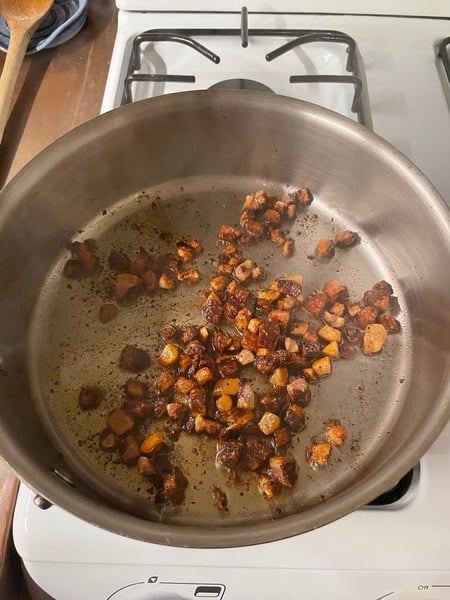 While the guanciale is cooking, shred the cheese and crack the eggs into a small mixing bowl. Add the yolks, shredded cheese and black pepper and beat until smooth.
While the guanciale is cooking, shred the cheese and crack the eggs into a small mixing bowl. Add the yolks, shredded cheese and black pepper and beat until smooth.
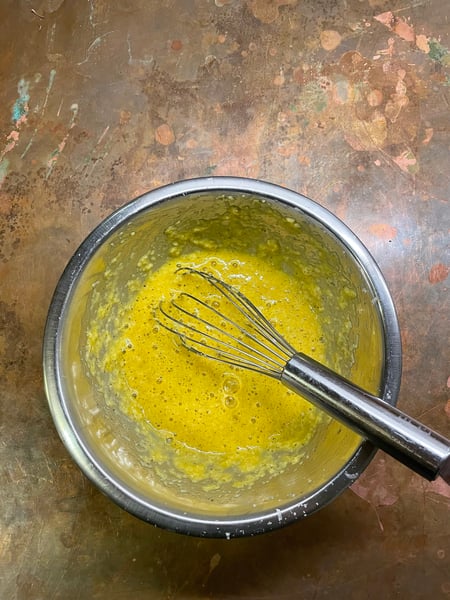 If you’re planning to use them, chop the savory and zest the grapefruit while the guanciale cooks as well.
If you’re planning to use them, chop the savory and zest the grapefruit while the guanciale cooks as well.
Once the guanciale is cooked, deglaze the pan with the chicken stock and add the chopped savory (if you’ve opted to forgo the stock and/or savory, simply skip this step), and reduce over high heat until the pan is almost dry. Turn the heat off and leave until the pasta is finished cooking.
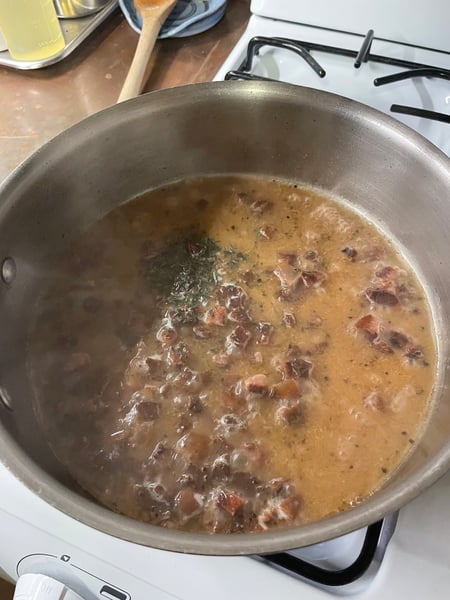
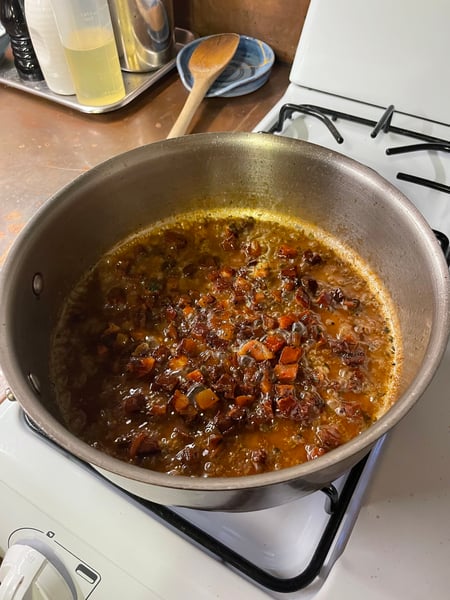 How will you know if the pasta is done? Easy, it says how long it takes on the box. Just kidding. The time estimates on boxed pasta are just that, estimates. They can give you an idea of when to start checking the pasta, but to determine if it's done to perfection there is no substitute for tasting. Pull a strand of pasta out of the pot, let it cool for a few seconds and eat it. It should be tender with just a little bite left. If you care to look, you should be able to see a small white dot in the center of a cross section of the noodle. This is what we call al dente.
How will you know if the pasta is done? Easy, it says how long it takes on the box. Just kidding. The time estimates on boxed pasta are just that, estimates. They can give you an idea of when to start checking the pasta, but to determine if it's done to perfection there is no substitute for tasting. Pull a strand of pasta out of the pot, let it cool for a few seconds and eat it. It should be tender with just a little bite left. If you care to look, you should be able to see a small white dot in the center of a cross section of the noodle. This is what we call al dente.
Some people insist they prefer their pasta cooked all the way through rendering it fully soft. Cook your pasta however you like, but if you’re one of these people, I really encourage you to give al dente another try. It shouldn’t be hard or tough in any way, simply just cooked so that you can feel every noodle as you bit through it.
Once your pasta is cooked, evacuate it from the pot and place it directly in the pan with the cooked guanciale. If you can, use a utensil to remove the pasta rather than duping the whole pot into a colander in the sink. This preserves the pasta water which will come in handy down the line if we decide we need to modify the consistency of the sauce.
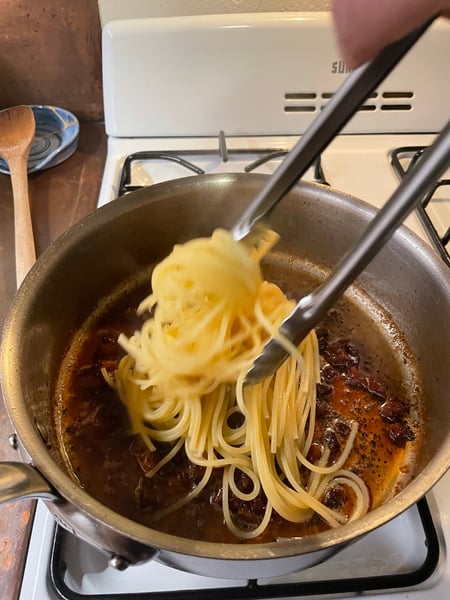 Put the pan back over low heat (low!) and add the egg and cheese mixture. Stir constantly until you see the cheese melt and the sauce start to thicken, then immediately turn the heat off. Continue to stir until the sauce has reached the desired consistency. It should be glossy and cling readily to the pasta. If it stops thickening you can return it to the heat, but be careful because just a little too much and your sauce will break and turn into grease and scrambled eggs.
Put the pan back over low heat (low!) and add the egg and cheese mixture. Stir constantly until you see the cheese melt and the sauce start to thicken, then immediately turn the heat off. Continue to stir until the sauce has reached the desired consistency. It should be glossy and cling readily to the pasta. If it stops thickening you can return it to the heat, but be careful because just a little too much and your sauce will break and turn into grease and scrambled eggs.
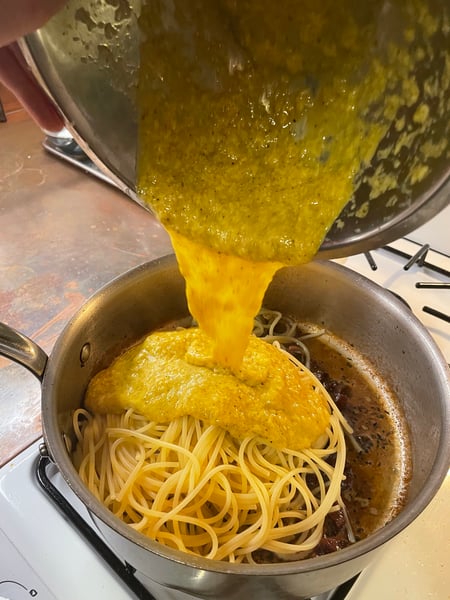
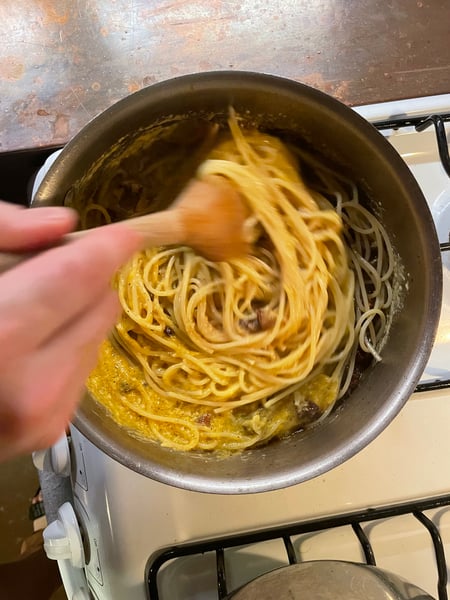
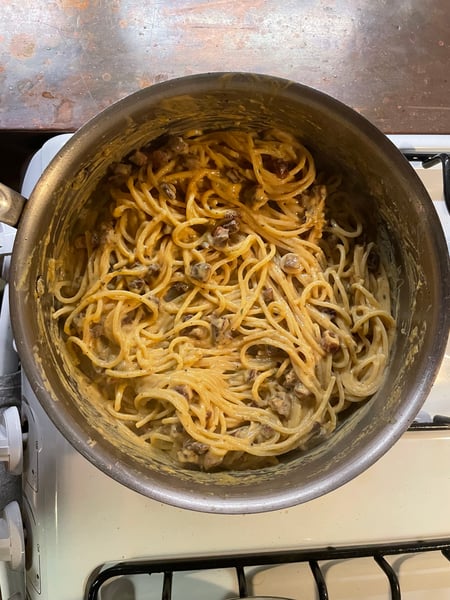
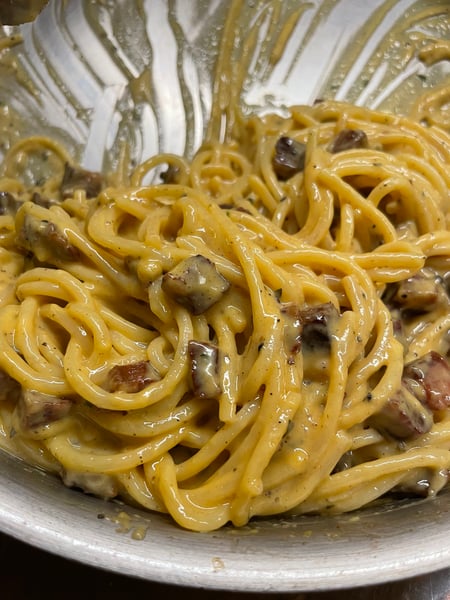 Season to taste (it won’t need much if any salt thanks to the salty meat and cheese), and add the grapefruit zest if using.
Season to taste (it won’t need much if any salt thanks to the salty meat and cheese), and add the grapefruit zest if using.
Now just plate up, and enjoy! If you like, you could garnish with more shredded cheese and/or a light drizzle of good quality olive oil.
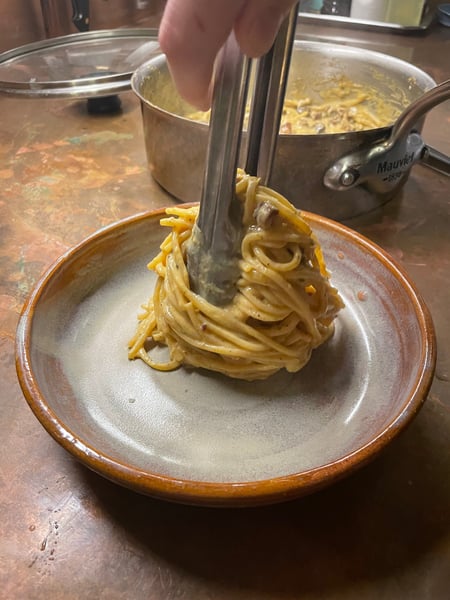 If this post has you craving even more Italian winter comfort food, I recommend checking out our upcoming virtual Gnocchi Al Forno which I’ll be teaching and am very much looking forward to. Together, we'll make:
If this post has you craving even more Italian winter comfort food, I recommend checking out our upcoming virtual Gnocchi Al Forno which I’ll be teaching and am very much looking forward to. Together, we'll make:
- Baked Gnocchi Al Forno with Italian Sausage-Tomato Ragu
- Mixed Green Salad with Lemon and Parmesan
See you there!
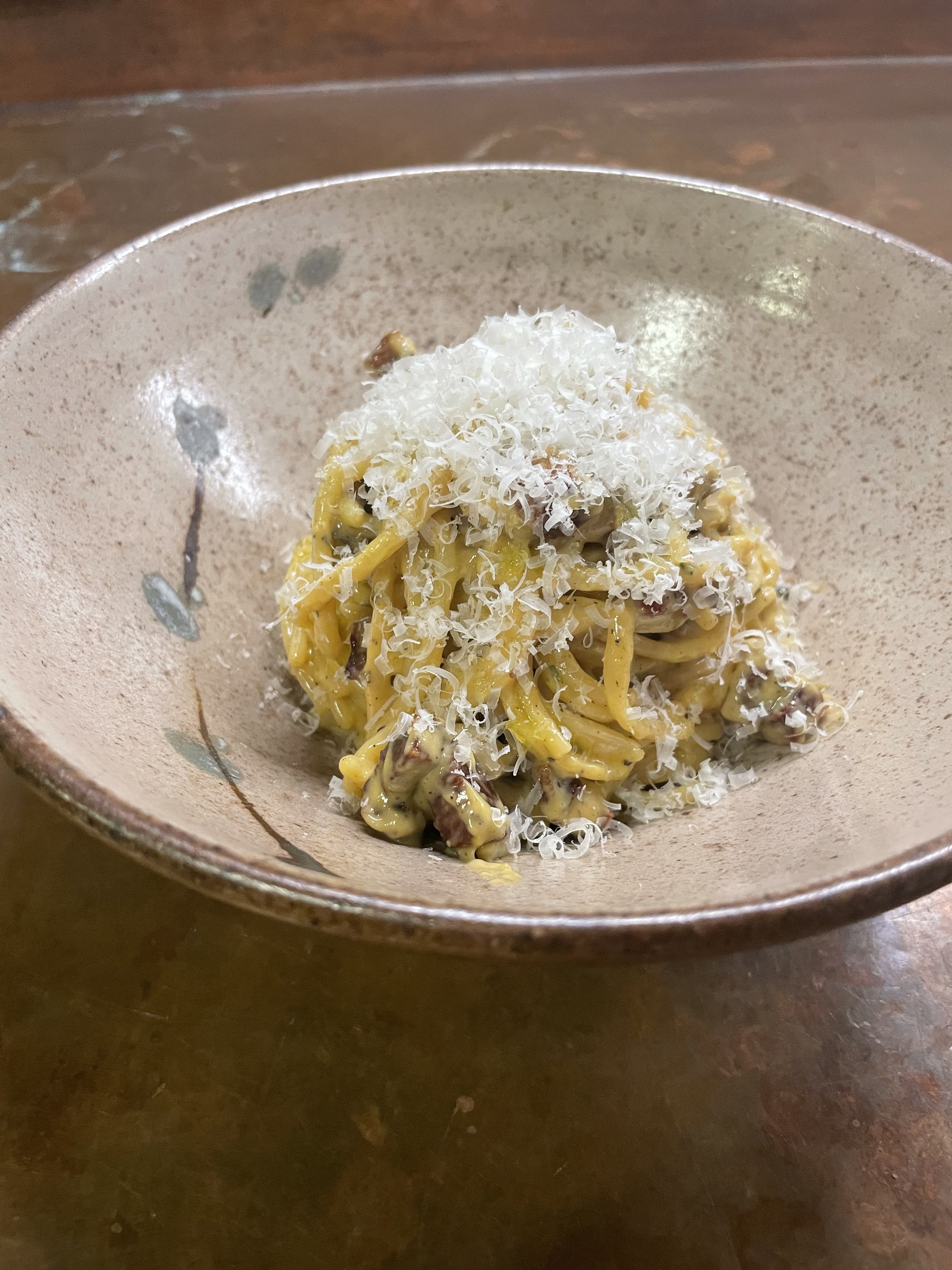
Spaghetti Carbonara
Ingredients
- 150-200 grams dried spaghetti (or long pasta of your choice)
- 100 grams Guanciale (or pancetta or bacon) cut into small dice
- 2 whole eggs
- 2 egg yolks
- 50 grams finely grated Parmigiano Reggiano (or Pecorino Romano if you prefer)
- 1 teaspoon finely ground black pepper
- 200 grams chicken stock (optional)
- 1 teaspoon grapefruit zest (optional)
- 1 teaspoon chopped winter savory (optional)
- Salt to taste
Instructions
- Place a large covered pot of salted water over high heat and bring to a boil. While it's heating, weigh out your pasta and guanciale.
- Dice the guanciale and get it cooking in a wide shallow pan set over medium-low heat.
- As soon as the water comes to a boil, drop in the pasta.
- Cook the guanciale, stirring occasionally, until the fat is well rendered and guanciale pieces are crispy.
- While the guanciale is cooking, shred the cheese and crack the eggs into a small mixing bowl. Add the yolks, shredded cheese and black pepper and beat until smooth.
- If you’re planning to use them, chop the savory and zest the grapefruit while the guanciale cooks as well.
- Once the guanciale is cooked, deglaze the pan with the chicken stock and add the chopped savory (if you’ve opted to forgo the stock and/or savory, simply skip this step), and reduce over high heat until the pan is almost dry. Turn the heat off and leave until the pasta is finished cooking.
- Once your pasta is cooked, evacuate it from the pot and place it directly in the pan with the cooked guanciale.
- Put the pan back over low heat and add the egg and cheese mixture. Stir constantly until you see the cheese melt and the sauce start to thicken, then immediately turn the heat off. Continue to stir until the sauce has reached the desired consistency.
- Season to taste, and add the grapefruit zest if using.
- Now just plate up, and enjoy! If you like, you could garnish with more shredded cheese and/or a light drizzle of good quality olive oil.


